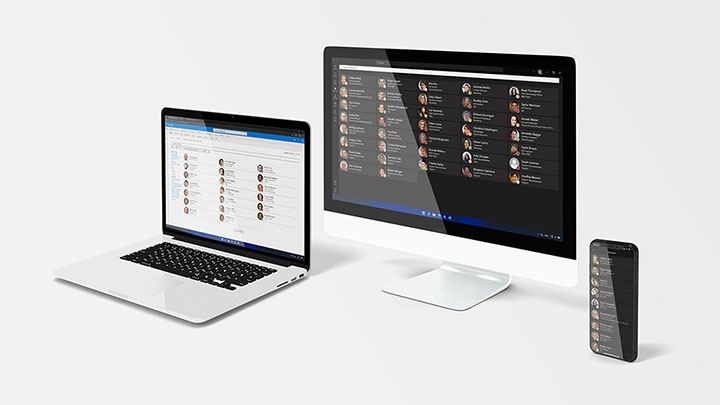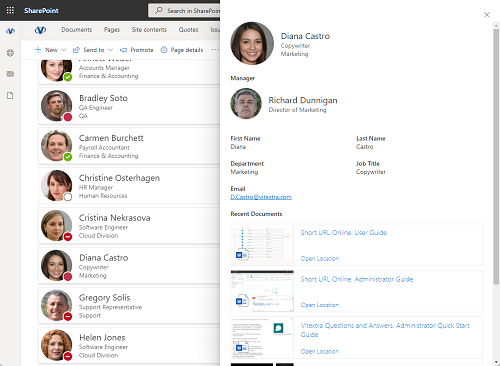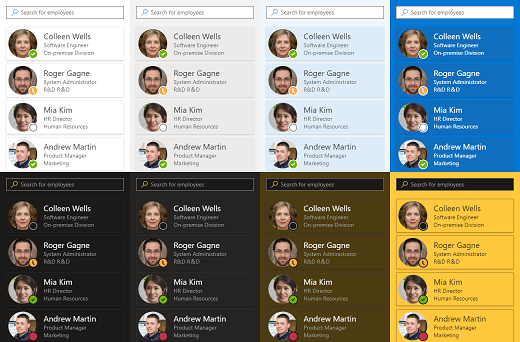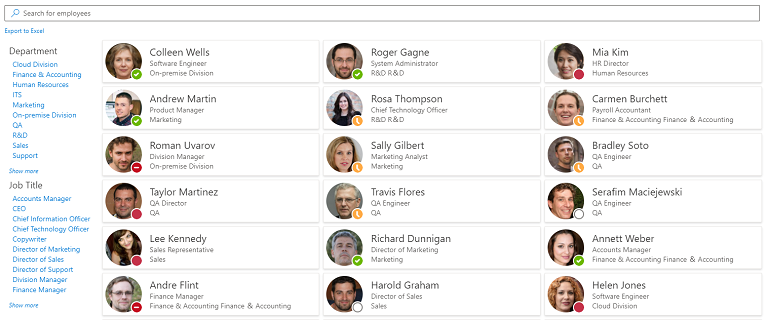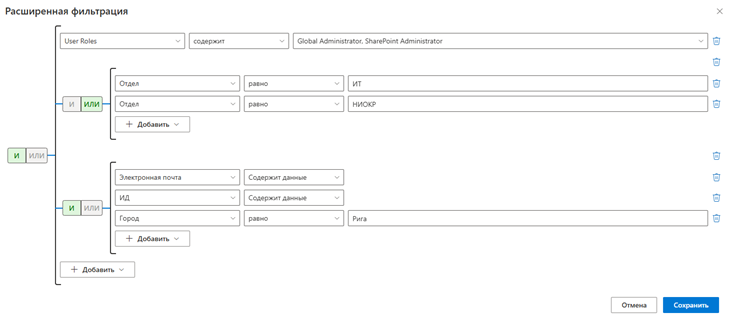Employee Directory. Обзор решения
Решение Vitextra Employee Directory включает в себя три веб-части:
Эти веб-части предназначены для расширения функциональности SharePoint и Microsoft Teams, предоставляя информацию о сотрудниках и возможность поиска.
В этой статье будут описаны основные возможности этих веб-частей.
SharePoint Framework
Приложение Employee Directory создано с использованием SharePoint Framework (SPFx) и может размещаться как на SharePoint Modern Pages, так и на Classic Pages, а также в Microsoft Teams. Это означает, что приложение можно использовать на разных платформах без ограничений. Приложение SPFx запускается в браузере в контексте учетной записи текущего пользователя.
📝 Примечание
Разрешения веб-частей SPFx не могут превышать разрешения, предоставленные текущему пользователю в Entra ID .
Более подробную информацию можно найти в посте «Защита данных при использовании приложения Vitextra».
Microsoft Graph
Веб-части Employee Directory используют Microsoft Graph API для извлечения информации о пользователях, их статусе присутствия в Teams и их расписаниях из Outlook. Взаимодействие между Microsoft Graph API и веб-частью осуществляется через собственный клиент, встроенный в SharePoint Framework.
Процесс извлечения данных:
- Веб-часть запрашивает токен из Entra ID для взаимодействия с Microsoft Graph
- Entra ID предоставляет токен на основе разрешений, предоставленных решению
- Веб-часть запрашивает данные из Microsoft Graph.
- Microsoft Graph предоставляет данные
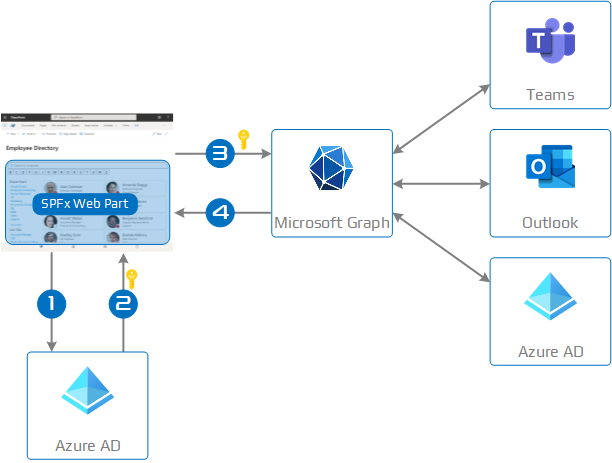
❗ Важно
Чтобы использовать Microsoft Graph API, вам необходимо утвердить необходимые разрешения API в Центре администрирования SharePoint для вашего решения.
Для приложения Employee Directory требуются следующие разрешения:
- Directory.Read.All
- User.Read.All
- Presence.Read.All
- Calendars.Read
Эти разрешения позволяют веб-частям получать доступ к информации о пользователе, отношениям менеджер/подчиненный и данным календаря.
📝 Примечание
Эти разрешения должны быть одобрены в Центре администрирования SharePoint.
Первые два разрешения, Directory.Read.All и User.Read.All, необходимы для получения информации о пользователях и их отношениях менеджер/подчиненный. Разрешение Presence.ReadAll требуется для получения текущего статуса присутствия пользователя в Microsoft Teams, а последнее разрешение, Calendars.Read, необходимо для доступа к данным из календаря пользователя.
📝 Примечание
Справочник сотрудников выполняет только операции чтения в Microsoft Graph.
Веб-части
Справочник сотрудников
Главная веб-страница представляет собой центр поиска и информации для сотрудников вашей организации.
Источник данных
Веб-часть Справочник сотрудников поддерживает как Entra ID, так и профили пользователей в качестве источника данных. При использовании профилей пользователей веб-часть извлекает информацию из службы поиска SharePoint.
Пользовательские атрибуты
Веб-части поддерживают пользовательские атрибуты для обоих источников данных: Microsoft Entra ID и профили пользователей. При использовании профилей пользователей необходимо определить пользовательские атрибуты в схеме поиска SharePoint. Дополнительные сведения о том, как это сделать, см. в статье базы знаний Отображение пользовательских атрибутов из Azure AD в Справочнике Сотрудников.
💡 Совет
Справочник сотрудников поддерживает настраиваемые атрибуты для отображения информации из них в результатах поиска.
Макет
Веб-часть имеет два варианта отображения результатов поиска: Контакты и Сведения.
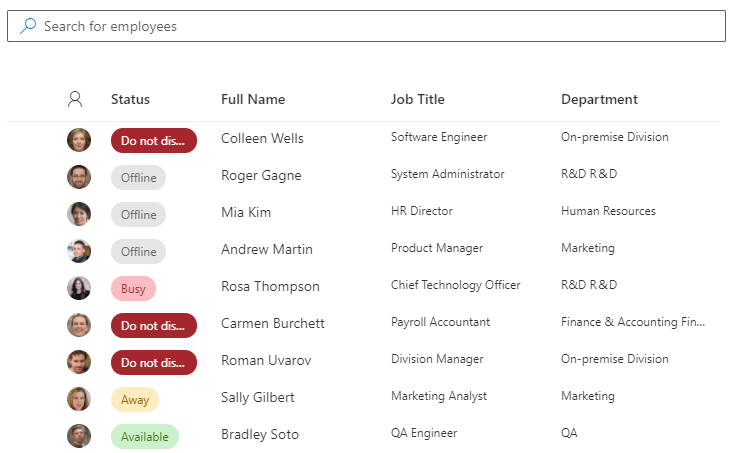
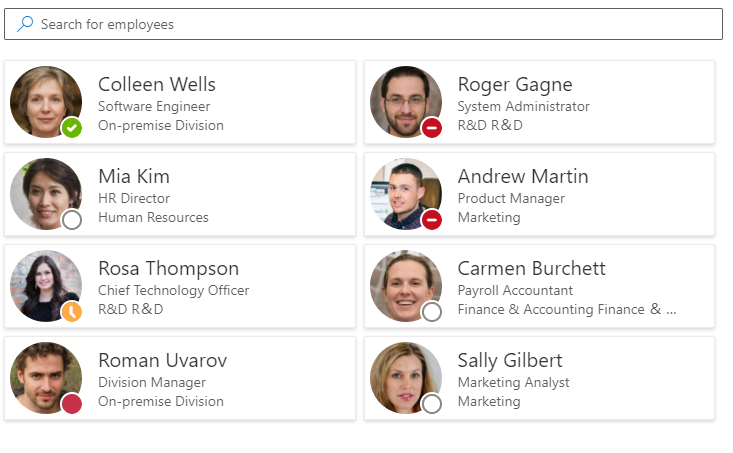
В режиме «Контакт» информация о сотруднике отображается в виде карточек. Вы можете указать, какие поля будут отображаться на каждой строке карточки. Количество полей (строк) зависит от размера карточки, указанного в настройках веб-части, при этом на карточке может быть не более четырех полей.
Режим просмотра «Сведения» позволяет вам выбирать, какие поля будут отображаться в списке и их порядок. Все столбцы, за исключением столбцов изображения и статуса, являются сворачиваемыми. Эти столбцы скрываются, если доступного места на странице недостаточно. Такой подход позволяет по возможности избежать использования горизонтальной прокрутки и динамически адаптироваться веб-части под доступное место на странице.
💡 Совет
Справочник сотрудников позволяет настраивать отображение атрибутов как в представлении «Контакты», так и в представлении «Сведения».
Панель сведений
При выборе сотрудника из результатов поиска пользователи могут просмотреть подробную информацию о нём. Сюда входит список недавно отредактированных документов сотрудником и информация о его доступности в этот день.
Варианты оформления
Все веб-части в решении Employee Directory автоматически наследуют тему сайта, на котором они расположены. Веб-части также поддерживают варианты оформления, которые можно указать для раздела на странице SharePoint. На рисунке ниже показана веб-часть в четырех различных цветовых вариациях для двух различных тем сайта SharePoint.
Кроме того, веб-часть «Справочник сотрудников» поддерживает темы по умолчанию и темные темы в Microsoft Teams.
Панель уточнения
Панель уточнения в справочнике сотрудников позволяет фильтровать результаты поиска на основе выбранных полей. Эта функциональность поддерживается службой поиска SharePoint и доступна только для источников данных профилей пользователей.
Панель уточнения предлагает широкий спектр опций:
- Порядок отображения полей
- Отображение количества результатов
- Сортировка по имени или количеству результатов
- Расположение панели фильтра (слева, справа, сверху)
💡 Совет
Справочник сотрудников поддерживает настраиваемые атрибуты профиля пользователя для панели уточнения.
Экспорт в Excel
Экспорт в Excel позволяет сохранять результаты поиска в виде файла Excel. Подробнее см. в статье Экспорт списка сотрудников в таблицу Excel.

📝 Примечание
Существуют некоторые ограничения функциональности экспорта:
- Ширина столбцов в экспортированной электронной таблице фиксирована.
- Стиль таблицы не может быть изменен и установлен на Синий, Стиль таблицы Средний 2.
Справочник сотрудников (Entra ID)
Специальная версия веб-части справочника сотрудников, которая поддерживает только Entra ID в качестве источника данных. Основная цель этой веб-части — предоставить полнофункциональный поиска пользователей в Entra ID. Внешний вид веб-части и макет результатов поиска полностью настраиваются и соответствуют стандартной веб-части справочника сотрудников.
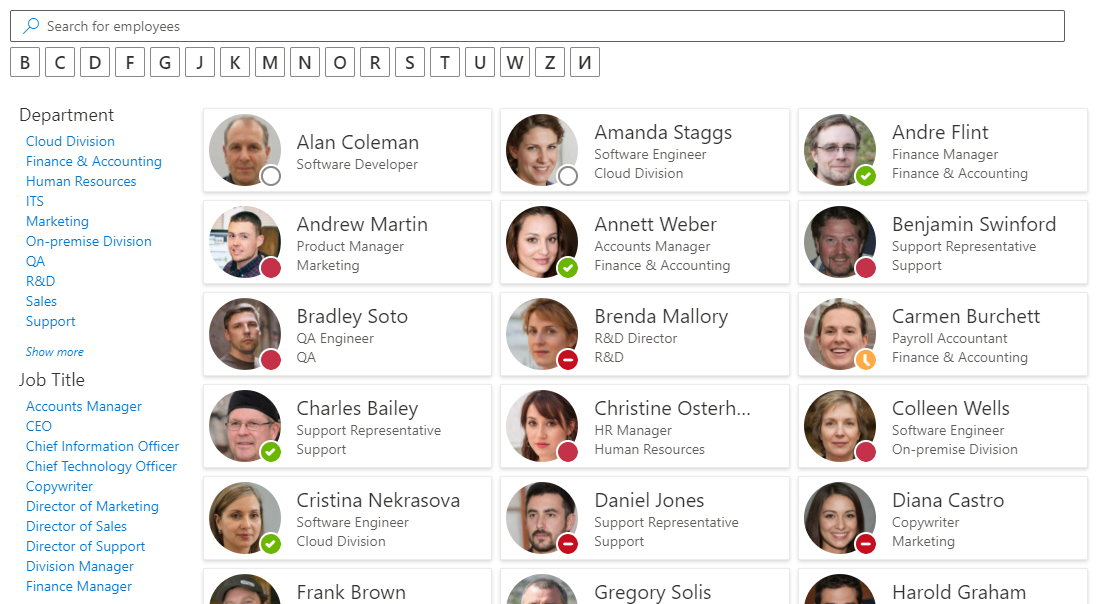
Поведение и возможности
Веб-часть Справочник сотрудников (Entra ID) ищет сотрудников, сначала извлекая полный список пользователей из Microsoft Entra ID. Такой подход позволяет реализовать следующие функции:
- Скрытие пользователей без лицензий: исключение пользователей, у которых нет назначенных лицензий, из результатов поиска.
- Выбор полей поиска: выбор атрибутов, которые будут использоваться для поиска сотрудников. Эти атрибуты могут быть скрыты при отображении результатов поиска.
- Предопределенные фильтры: Указание набора фильтров через параметры веб-части для ограничения области поиска сотрудников. Эти фильтры всегда применяются и не могут быть проигнорированы пользователями.
Конструктор запросов — это надежный инструмент, разработанный для помощи в создании сложных запросов для получения подробной информации о пользователях из Entra ID. Его интуитивно понятный интерфейс позволяет как администраторам, так и разработчикам создавать точные запросы без необходимости глубоких знаний языков запросов.
💡 Совет
Справочник сотрудников (Entra ID) позволяет пользователям указывать фильтр, используя все доступные атрибуты, включая настраиваемые.
Алфавитная навигация: Алфавитная навигация автоматически генерируется на основе данных пользователя в Entra ID. Первая буква фамилии сотрудника используется для создания списка букв.
Панель уточнения: Справочник сотрудников (Entra ID) позволяет использовать различные атрибуты сотрудников для создания панели уточнения.
❗ Важно
Если количество активных пользователей в Entra ID превышает 2000, инициализация веб-части на странице может занять более одной секунды.
Новые сотрудники
Веб-часть «Новые сотрудники» отображает список пользователей, которые недавно были созданы в Entra ID.
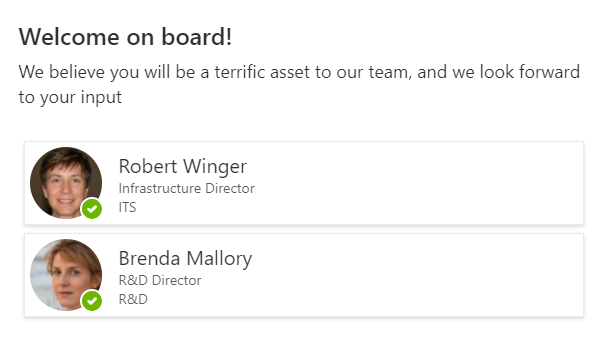
В настройках веб-страницы можно указать количество сотрудников и период времени, в течение которого будут видны пользователи, созданные в Microsoft Entra ID.
📝 Примечание
Панель сведений в настоящее время недоступна для новых сотрудников.
Заключение
Решение Vitextra Employee Directory предлагает надежный и универсальный инструмент для управления и доступа к информации о сотрудниках в SharePoint и Microsoft Teams. Используя возможности SharePoint Framework и Microsoft Graph API, оно обеспечивает бесшовную интеграцию и комплексное извлечение данных из Microsoft Entra ID.
Гибкость решения с такими функциями, как настраиваемые представления, варианты тем и возможности экспорта, делает его бесценным активом для организаций, стремящихся улучшить внутреннюю коммуникацию и сотрудничество. Поскольку Vitextra продолжает внедрять инновации, пользователи могут рассчитывать на еще большее количество улучшений и поддержку дополнительных функций, гарантируя, что Employee Directory останется передовым решением для современных рабочих мест.
